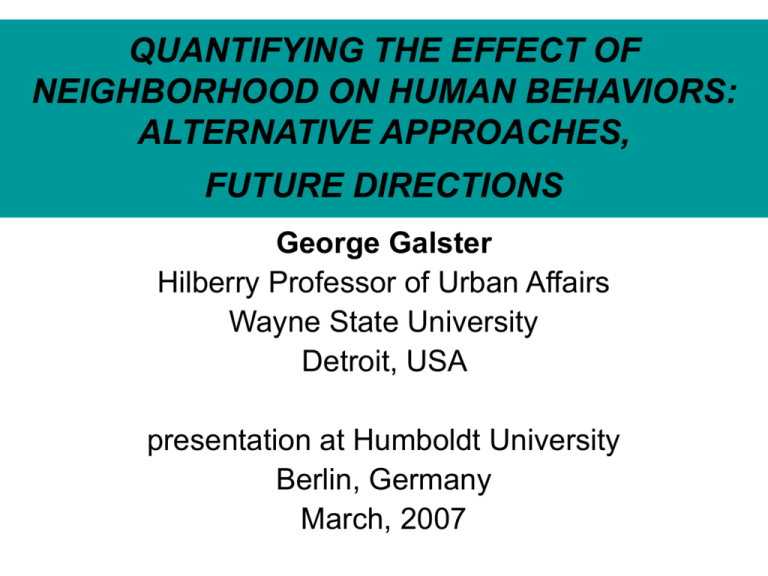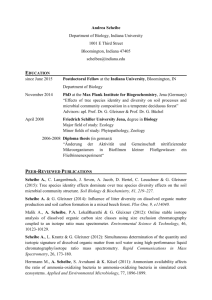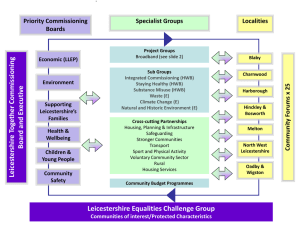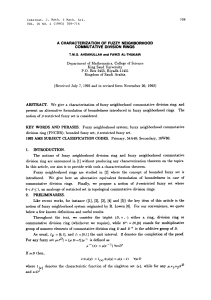THE ECONOMICS OF ECONOMICALLY MIXED COMMUNITIES
advertisement

QUANTIFYING THE EFFECT OF NEIGHBORHOOD ON HUMAN BEHAVIORS: ALTERNATIVE APPROACHES, FUTURE DIRECTIONS George Galster Hilberry Professor of Urban Affairs Wayne State University Detroit, USA presentation at Humboldt University Berlin, Germany March, 2007 OVERVIEW: QUESTIONS ADDRESSED • What Are the Main Methodological Challenges of Quantifying Effects of Neighborhood on Human Behaviors? • How Can We Overcome These Methodological Challenges? • What Are Promising Future Directions? George Galster, Wayne State University, Detroit, USA; presentation at HumboldtUniversity, 2007 Main Methodological Challenges of Quantifying Effects of Neighborhood • Defining “Neighborhood” • Measuring Neighborhood Characteristics • Endogeneity • Selection George Galster, Wayne State University, Detroit, USA; presentation at Humboldt University, 2007 Main Methodological Challenges of Quantifying Effects of Neighborhood: 1 Defining “Neighborhood”: CHALLENGES: What is the appropriate scale? Does appropriate scale vary by causal mechanism of neighborhood effect presumed? George Galster, Wayne State University, Detroit, USA; presentation at Humboldt University, 2007 How Overcome Challenge of Defining Neighborhood? RESPONSE: Operationalize neighborhood at different administrative district scales George Galster, Wayne State University, Detroit, USA; presentation at Humboldt University, 2007 Main Methodological Challenges of Quantifying Effects of Neighborhood:2 Measuring Neighborhood Characteristics: CHALLENGE: Lack of direct measures of appropriate causal mechanisms; Correlated characteristics George Galster, Wayne State University, Detroit, USA; presentation at Humboldt University, 2007 How Overcome Challenge of Measuring Neighborhood Character? RESPONSE: factor analysis; proxy variables (Sampson et al.) George Galster, Wayne State University, Detroit, USA; presentation at Humboldt University, 2007 Main Methodological Challenges of Quantifying Effects of Neighborhood: 3 Endogeneity: CHALLENGE: “Reflection Problem” in cross-sectional samples (Manski); Simultaneity of Choosing Home Own/Rent Status, Mobility Status, Neighborhood Characteristics George Galster, Wayne State University, Detroit, USA; presentation at Humboldt University, 2007 Main Methodological Challenges of Quantifying Effects of Neighborhood:3 Simultaneity: Neigh’d choice Tenure choice Mobility Behavioral Outcomes George Galster, Wayne State University, Detroit, USA; presentation at Humboldt University, 2007 How Overcome Challenge of Endogeneity? RESPONSE: Instrumental Variables (IVs) George Galster, Wayne State University, Detroit, USA; presentation at Humboldt University, 2007 Main Methodological Challenges of Quantifying Effects of Neighborhood: 4 Selection: CHALLENGE: Behaviorit = a + b[Observedit] +c[Unobservedit] + d[Neighborh’dit] + e [Neighborhood] Unobserved Behavior George Galster, Wayne State University, Detroit, USA; presentation at Humboldt University, 2007 How Overcome Challenge of Selection? RESPONSE 1: Econometric adjustments to non-experimental panel datasets: • Modeling Selection Explicitly • Differencing • Fixed Effects • Sibling Comparisons • Instrumental Variables George Galster, Wayne State University, Detroit, USA; presentation at Humboldt University, 2007 How Overcome Challenge of Selection? RESPONSE 2: Experimental, random assignment datasets: Moving To Opportunity (MTO): • 1994 in 5 U.S. metros; 4,700 households • Public housing / rent vouchers no aid / vouchers with aid but must locate in <10% poverty area for one year • Compare groups over time George Galster, Wayne State University, Detroit, USA; presentation at Humboldt University, 2007 How Overcome Challenge of Selection? RESPONSE 3: Natural-experiment, quasirandom assignment panel datasets: • PHA desegregation: Gautreaux (Rosenbaum et al.), Yonkers (Briggs et al.) • Social housing allocation: Denver-USA (Galster); Canada (Oreopolis) • Immigrant re-settlement (Sweden: Edin, Fredricksson, Aslund;) George Galster, Wayne State University, Detroit, USA; presentation at Humboldt University, 2007 Promising Future Directions: 1 (1) Exploit Longitudinal Social Register Data (Andersson [SWE]; Musterd [NETH]) - Allows GIS-specified, individual-centered “neighborhoods” to be defined and their characteristics measured precisely and comprehensively George Galster, Wayne State University, Detroit, USA; presentation at Humboldt University, 2007 Promising Future Directions: 2 (2) Exploit natural experiments - Overcomes endogeneity and selection challenges without econometric fixes of questionable power George Galster, Wayne State University, Detroit, USA; presentation at Humboldt University, 2007 Promising Future Directions: 3 (3) Non-linear (threshold) effects must be considered. In U.S., negative externalities not occur until: % poor in neighborhood > approx. 10%-15% CRUCIAL POLICY IMPLICATIONS (Galster, 1998, 2002, 2007) George Galster, Wayne State University, Detroit, USA; presentation at Humboldt University, 2007 Promising Future Directions 3: Evidence on Threshold Effects in US Summary of Observed Relationships Between Neighborhood Poverty Rates and Individual Behavioral Outcomes in U.S. “bad” behaviors* C A D l cia So osts C E F higher .1 0 lower .2 .3 .4 .5 .6 Proportion Poor in Neighborhood F´ E´ l cia its So nef Be D´ C´ “good” behaviors** A´ Source: U.S. statistical studies reviewed in Galster (2002) * crime, school leaving, duration of poverty as young adult ** hours of work, income, wages George Galster, Wayne State University, Detroit, USA; presentation at Humboldt University, 2007 CONCLUSION: Challenges of Quantifying Effects of Neighborhood • Defining “Neighborhood” • Measuring Neighborhood Characteristics • Endogeneity • Selection George Galster, Wayne State University, Detroit, USA; presentation at Humboldt University, 2007 CONCLUSION: Overcoming Methodological Challenges • Defining “Neighborhood”: various scales • Measuring Neighborhood Characteristics: factor analysis, proxy variables • Endogeneity: Instrumental Variables • Selection: Econometric fixes; randomassignment experiments; natural experiments George Galster, Wayne State University, Detroit, USA; presentation at Humboldt University, 2007 CONCLUSION: Promising New Directions • Exploit longitudinal social register datasets • Exploit natural experiments • Probe for non-linear neighborhood / behavioral outcome relationships George Galster, Wayne State University, Detroit, USA; presentation at Humboldt University, 2007 THANK YOU; QUESTIONS? REFERENCES Galster, G. (2001). On the Nature of Neighborhood, Urban Studies 38(12), 2111-2124. Galster, G. (2002). An Economic Efficiency Analysis of Deconcentrating Poverty Populations. Journal of Housing Economics 11, 303-329. Galster, G. (2003) Investigating Behavioral Impacts of Poor Neighborhoods: Towards New Data and Analytic Strategies. Housing Studies 18(3), 893-914. Galster, G. (2005). Neighborhood Mix, Social Opportunities, and the Policy Challenges of an Increasingly Diverse Amsterdam. Amsterdam, Netherlands: University of Amsterdam, Dept. of Geography, Planning, and International Development Studies; available at: http://www.fmg.uva.nl/amidst/object.cfm/objectid=7C149E7C-EC9F-4C2E-91DB7485C0839425 Galster, G. (2007) Neighbourhood social mix as a goal of housing policy: A theoretical analysis. European Journal of Housing Policy 7(1), pp. 19-43. Galster, G. (forthcoming). Should Policy Strive for Social Mix in Neighborhoods? A Review of the European Evidence Base. Housing Studies. Galster, G., Andersson, R., Musterd, S., & Kauppinen, T. (forthcoming). The Effect of Neighborhood Income Distribution on Individuals’ Income Prospects. Journal of Urban Economics. Galster, G., Cutsinger, J. & Malega, R. (2006). “The Social Costs of Concentrated Poverty: Externalities to Neighboring Households and Property Owners and the Dynamics of Decline,” paper presented at “The Future of Rental Housing” conference, Joint Center for Housing Studies, Harvard University, Nov. 14. Galster, G. Marcotte, D., Mandell, M. Wolman, H. & Augustine, N. (forthcoming). Effects of Childhood Poverty on Young Adult Fertility, Education, and Incomes. Housing Studies Galster, G., Quercia, R. & Cortes, A. (2000). Identifying Neighborhood Thresholds: An Empirical Exploration, Housing Policy Debate 11(3), 701-732. Galster, G., Tatian, P., Santiago, A., Pettit, K. & Smith, R. (2003). Why NOT in My Back Yard? The Neighborhood Impacts of Assisted Housing. New Brunswick, NJ: Rutgers University / Center for Urban Policy Research Press. Galster, G., & Zobel, A. (1998). Will dispersed housing programmes reduce social problems in the US? Housing Studies, 13(5), 605-622. George Galster, Wayne State University, Detroit, USA; presentation at Humboldt University, 2007





